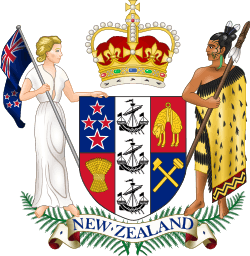Seales v Attorney-General
| Seales v Attorney-General | |
|---|---|
 | |
| Court | Wellington High Court |
| Decided | 4 June 2015 |
| Citation(s) | [2015] NZHC 1239 |
| Transcript(s) | Available here |
| Court membership | |
| Judge(s) sitting | Collins J |
| Keywords | |
| Euthanasia, Crimes Act 1961, New Zealand Bill of Rights Act 1990 | |
Seales v Attorney-General [2015] NZHC 1239 was a 2015 court case concerned with whether a doctor could assist a terminally ill patient in ending her own life. Wellington lawyer Lecretia Seales, terminally ill from a brain tumour, sought High Court declarations to the effect that her doctor would not be committing murder, manslaughter or assisting a suicide if he assisted in her euthanasia. [1] Seales also sought, as an alternative, that the court make declarations that the Crimes Act was not consistent with the New Zealand Bill of Rights Act 1990.[2] The Court declined to make any of the declarations sought by Seales.[3] Seales died of her illness the day after the judgment was delivered.[4]
Background
In 2011 Seales was diagnosed with a brain tumour. She received brain surgery, chemotherapy and radio therapy but her condition continued to deteriorate. In 2015 she put a case to the High Court to challenge New Zealand law for her right to die with the assistance of her GP, asking for a declaration that her GP would not risk conviction.[5][6][7]
The statutory background to the decision is the Crimes Act 1961 and its prohibitions on: homicide (section 160); aiding and abetting suicide (section 179(b)); consenting to death (section 63); and acceleration of death (section 164).[8] In New Zealand these are the legal barriers to euthanasia.
Seales's application relied on giving the word suicide an alternative meaning to the ordinary dictionary definition, as required by section 6 of the New Zealand Bill of Rights Act 1990.[9] Accordingly, during the hearing, "Mr Curran, who appeared with Dr Butler as counsel for Ms Seales, submitted s 63 of the Crimes Act should be construed so as not to preclude consent as a defence to either murder or manslaughter where the deceased has lawfully asserted his or her NZBORA rights."[10]
This legal argument was summarised in a law journal article prior to the hearing;
| “ | This alternative meaning would distinguish between the sorts of intentional self-inflicted deaths we ordinarily think of as being “suicide” (the lovesick teen, the family breadwinner facing financial crisis, etc.) and the act of a competent, terminally ill person who is seeking (as in Ms Seales’ case) to choose a more peaceful death when brought to death’s door by the advance of disease and enduring unbearable suffering. | ” | |
| — Kathryn Tucker and Andrew Geddis, Litigating for a more peaceful death[11] | |||
Judgment
Justice Collins declined to grant any of the declarations sought;
| “ | Although Ms Seales has not obtained the outcomes she sought, she has selflessly provided a forum to clarify important aspects of New Zealand law. The complex legal, philosophical, moral and clinical issues raised by Ms Seales’ proceedings can only be addressed by Parliament passing legislation to amend the effect of the Crimes Act. I appreciate Parliament has shown little desire to engage in these issues. The three private members bills that have attempted to address the broad issues raised by Ms Seales’ proceeding gained little legislative traction. However, the fact that Parliament has not been willing to address the issues raised by Ms Seales’ proceeding does not provide me with a licence to depart from the constitutional role of Judges in New Zealand. | ” | |
| — Collins J, Seales v Attorney-General[12] | |||
Justice Collins noted a potential problem with adopting an alternative meaning of suicide was in giving effect to section 41 of the Crimes Act, which allows force to be used to prevent a suicide; "It is difficult to see how a person who intervenes to prevent a suicide can assess whether or not he or she is intervening in a case of “rational” suicide."[13] Collins also noted the Canadian Supreme Court in Carter v Canada (AG) had given near identical provisions of Canadian criminal law prohibiting euthanasia the same meaning and that there was authority from the United Kingdom endorsing his interpretation of section 179(b) of the Crimes Act.[14]
See also
References
- ↑ Seales v Attorney-General [2015] NZHC 1239 at [4-6].
- ↑ Seales v Attorney-General [2015] NZHC 1239 at [10].
- ↑ Seales v Attorney-General [2015] NZHC 1239 at [4-6].
- ↑ Seales v Attorney-General [2015] NZHC 1239 at postscript.
- ↑ "Lecretia Seales story: 'Heartbreaking' but 'no place for the courts' say Family First". The New Zealand Herald. 21 March 2015. Retrieved 5 June 2015.
- ↑ "Lecretia Seales: Lawyer with cancer embarks on challenge to New Zealand's euthanasia laws". Australian Broadcasting Corporation. Retrieved 5 June 2015.
- ↑ "Judge thanks woman for right-to-die case". Radio New Zealand. Retrieved 5 June 2015.
- ↑ Seales v Attorney-General [2015] NZHC 1239 at [82-85].
- ↑ Seales v Attorney-General [2015] NZHC 1239 at [88].
- ↑ Seales v Attorney-General [2015] NZHC 1239 at [89].
- ↑ Tucker, Kathryn; Geddis, Andrew. "Litigating for a more peaceful death" (PDF). Retrieved 31 July 2015.
- ↑ Seales v Attorney-General [2015] NZHC 1239 at [211].
- ↑ Seales v Attorney-General [2015] NZHC 1239 at [140].
- ↑ Seales v Attorney-General [2015] NZHC 1239 at [149-150].